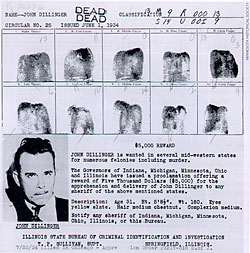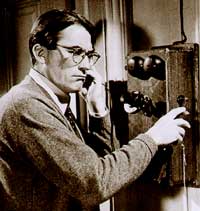For the Record
By Elizabeth Stawicki
Augusta 13, 1999
Imagine Minnesota without a legal system. That was the case before 1849 when Minnesota, then a territory, had no judges and no courtrooms to settle disputes.
But 150 years ago this month, that all changed as Minnesota's first justice - Aaron Goodrich - was sworn in near the banks of the Mississippi river in Stillwater.
Goodrich's story and other accounts of the famous and infamous in Minnesota justice are chronicled in a new book, "For the Record: 150 Years of Law and Lawyers in Minnesota." 250 legal enthusiasts dug into historical archives to piece together the history of Minnesota's legal profession.
WOOD FOSTER BELIEVES to see where you're going, you have to look where you've been. It was with that in mind that Foster, who took over as President of the Minnesota bar last month, compiled the often-colorful stories that detail the history of Minnesota's legal profession. Among them, is the journal of an 1800s lawyer who describes his commute.
Between 1849 and 1911, those convicted of premeditated murder were punished with death-by-hanging in the basement of the Ramsey County Courthouse in St Paul. Foster says the state's last hanging in 1906 was badly botched.
There are stories of the infamous in the 1920s and '30s; gangsters such as
John Dillinger (shown above) and Baby Face Nelson found sanctuary in St Paul.
Police Chief William O'Connor tolerated vice and allowed gangsters to roam freely as long as they didn't cause trouble within the city limits.
There's an account of the celebrated criminal trial of business tycoon Wilbur Foshay. Foshay, for whom the Foshay Tower in Minneapolis is named, was tried in federal court with mail and securities fraud. That trial ultimately led to a murder-suicide involving a juror.
Foshay and his associate were convicted after the second trial and sentenced to
15 years at Leavenworth. President Franklin D Roosevelt pardoned the two after
they served three years.
While much of Minnesota's legal system is rooted in the prairie days of the 1850s, Foster argues that many of the profession's true pioneers walk among us today.
Foster says if there's one element that's constant throughout Minnesota's legal
history, it's that lawyers have always had, an image problem.
By Elizabeth Stawicki
Augusta 13, 1999
|
|
RealAudio 3.0 |
|
|
|
|
|
||
|
|
||
Goodrich's story and other accounts of the famous and infamous in Minnesota justice are chronicled in a new book, "For the Record: 150 Years of Law and Lawyers in Minnesota." 250 legal enthusiasts dug into historical archives to piece together the history of Minnesota's legal profession.
WOOD FOSTER BELIEVES to see where you're going, you have to look where you've been. It was with that in mind that Foster, who took over as President of the Minnesota bar last month, compiled the often-colorful stories that detail the history of Minnesota's legal profession. Among them, is the journal of an 1800s lawyer who describes his commute.
Foster: He had to go to a motion at the Goodhue County seat where Red Wing is. He said he was called down from Traverse des Sioux where he was residing to respond to Judge Chatfield. "I paddled a canoe down the torturous course of the Minnesota River for about a 150 miles and attended to the business, sold the canoe for $3 and walked to my home, a distance straight across the county of 90 miles."Besides frontier life, the history also illustrates some of the more notorious incidents that shaped Minnesota law. One particularly gruesome example led to the state's ban on capital punishment.
Between 1849 and 1911, those convicted of premeditated murder were punished with death-by-hanging in the basement of the Ramsey County Courthouse in St Paul. Foster says the state's last hanging in 1906 was badly botched.
Foster: The rope stretched about 8 1/2 inches and the neck stretched another four, and the man's feet were on the floor and it took him a long time to die. At the time there was a law on the books that prevented newspapers from reporting on executions, but they did it anyway. There were prosecutions of newspapers that arose. Because that led to so much attention on the issue, that ultimately led to the repeal of capital punishment in Minnesota.
|
|
|
|
|
||
|
|
||
Police Chief William O'Connor tolerated vice and allowed gangsters to roam freely as long as they didn't cause trouble within the city limits.
There's an account of the celebrated criminal trial of business tycoon Wilbur Foshay. Foshay, for whom the Foshay Tower in Minneapolis is named, was tried in federal court with mail and securities fraud. That trial ultimately led to a murder-suicide involving a juror.
Foster: She was accused of having worked for one of the defendants. Apparently, she had worked for one of them for 10 days and not disclosed that during jury selection and held out for an acquittal. So there was a mistrial and on the second trial, he was convicted. But she was prosecuted for perjury, convicted and killed herself and her entire family before reporting for the six-month jail sentence that she received.
|
|
|
|
|
||
|
|
||
While much of Minnesota's legal system is rooted in the prairie days of the 1850s, Foster argues that many of the profession's true pioneers walk among us today.
Foster: The whole question of diversity in the practice has changed radically. In 1970, there were only a handful of women practicing in the state and even fewer minority lawyers. Vast inroads have been made but there's still a long way to go.Even with prominent jurists such as Court of Appeals Chief Judge Edward Toussaint, Justice Alan Page and Chief Justice Kathleen Blatz, women and minorities have faced hurdles their white, male counterparts have not. The Hennepin County Bar uncovered a solid glass ceiling in place in Twin Cities law firms, government and corporate law offices as late as 1993.
|
|
|
|
|
||
|
|
||
Foster: I read a bar president's statement in 1910 or 1915 in which he said, "it's been 40 or 50 years since people really had respect for our profession." I think we all look back think we've passed the golden era. I have come to think that that time did not exist; it's just a device that we used to make ourselves feel better. As I grew up my father was a lawyer, I had that image, Gregory Peck, Atticus Finch kind of image of what lawyers did.Perhaps the image problem for Minnesota's legal profession stems from the state's first chief justice, Aaron Goodrich, who was appointed 150 years ago. After two years on the bench, President Millard Filmore removed him from office by demand of several prominent Minnesota attorneys.
|
|
|
|
|
||
|
|
||
Foster: The lawyers said, Chief Justice Goodrich's conduct would disgrace him in any civilized society and urging he should be abated as a common nuisance. Apparently he did a certain amount of imbibing on the bench, but it's unclear as to what he did; but he sure ticked off a lot of people.The book, "For the Record: 150 Years of Law and Lawyers in Minnesota" is available at all state historical societies, and at about 500 libraries.





